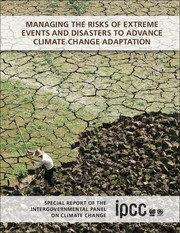 Managing the Risks of Extreme Events and Disasters to Advance Climate Change Adaptation
Managing the Risks of Extreme Events and Disasters to Advance Climate Change Adaptation Book contents
- Frontmatter
- Contents
- Section I
- Section II
- Section III
- Chapter 1 Climate Change: New Dimensions in Disaster Risk, Exposure, Vulnerability, and Resilience
- Chapter 2 Determinants of Risk: Exposure and Vulnerability
- Chapter 3 Changes in Climate Extremes and their Impacts on the Natural Physical Environment
- Chapter 4 Changes in Impacts of Climate Extremes: Human Systems and Ecosystems
- Chapter 5 Managing the Risks from Climate Extremes at the Local Level
- Chapter 6 National Systems for Managing the Risks from Climate Extremes and Disasters
- Chapter 7 Managing the Risks: International Level and Integration across Scales
- Chapter 8 Toward a Sustainable and Resilient Future
- Chapter 9 Case Studies
- Section IV
- Index
- References
Chapter 6 - National Systems for Managing the Risks from Climate Extremes and Disasters
from Section III
Published online by Cambridge University Press: 05 August 2012
- Frontmatter
- Contents
- Section I
- Section II
- Section III
- Chapter 1 Climate Change: New Dimensions in Disaster Risk, Exposure, Vulnerability, and Resilience
- Chapter 2 Determinants of Risk: Exposure and Vulnerability
- Chapter 3 Changes in Climate Extremes and their Impacts on the Natural Physical Environment
- Chapter 4 Changes in Impacts of Climate Extremes: Human Systems and Ecosystems
- Chapter 5 Managing the Risks from Climate Extremes at the Local Level
- Chapter 6 National Systems for Managing the Risks from Climate Extremes and Disasters
- Chapter 7 Managing the Risks: International Level and Integration across Scales
- Chapter 8 Toward a Sustainable and Resilient Future
- Chapter 9 Case Studies
- Section IV
- Index
- References
Summary
Executive Summary
This chapter assesses how countries are managing current and projected disaster risks, given knowledge of how risks are changing with observations and projections of weather and climate extremes [Table 3–2, 3.3], vulnerability and exposure [4.3], and impacts [4.4]. It focuses on the design of national systems for managing such risks, the roles played by actors involved in the system, and the functions they perform, acknowledging that complementary actions to manage risks are also taken at local and international level as described in Chapters 5 and 7.
National systems are at the core of countries' capacity to meet the challenges of observed and projected trends in exposure, vulnerability, and weather and climate extremes (high agreement, robust evidence). Effective national systems comprise multiple actors from national and sub-national governments, private sector, research bodies, and civil society, including community-based organizations, playing differential but complementary roles to manage risk according to their accepted functions and capacities. These actors work in partnership across temporal, spatial, administrative, and social scales, supported by relevant scientific and traditional knowledge. Specific characteristics of national systems vary between countries and across scales depending on their socio-cultural, political, and administrative environments and development status. [6.2]
The national level plays a key role in governing and managing disaster risks because national government is central to providing risk management-related public goods as it commonly maintains financial and organizational authority in planning and implementing these goods (high agreement, robust evidence). National governments are charged with the provision of public goods such as ensuring the economic and social well-being, safety, and security of their citizens from disasters, including the protection of the poorest and most vulnerable citizens. They also control budgetary allocations as well as creating legislative frameworks to guide actions by other actors.
- Type
- Chapter
- Information
- Managing the Risks of Extreme Events and Disasters to Advance Climate Change AdaptationSpecial Report of the Intergovernmental Panel on Climate Change, pp. 339 - 392Publisher: Cambridge University PressPrint publication year: 2012
References
- 67
- Cited by


